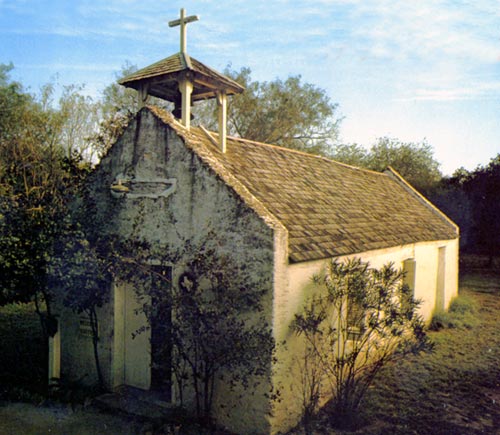La Lomita, which means “Little Hill” in Spanish, is the name given to a low rise in the otherwise flat Rio Grande Valley of Texas and to the ranch surrounding it.

At least from 1852, the time of the second entry of the Oblates into Texas, the missionaries made regular pastoral stops at La Lomita Ranch.
Father Pierre-Fourier Parisot (1827-1903) and Father Pierre-Yves Kéralum (1817-1872) acquired the ranch as a gift to the Oblates from Mr. René Guillard of Reynosa, Mexico, on February 27, 1861. It consisted of Spanish Land Grants Porciones 55 and 57, to which Porcion 56 was added by purchase in 1883 (Bretault, vol. I, p. 87). In 1767 King Charles III of Spain had ordered 400 porciones to be surveyed and granted, each measuring about 3/4 of a mile along the river front and from 11 to 16 miles inland. Accordingly, the Oblate ranch covered about 20 square miles (Quinlivan, p.17).
In 1865, the missionaries built a small chapel and living quarters on the ranch to serve as a mid-Valley stop-over for their horseback circuits (Cavalry of Christ), while Brownsville and Roma remained as the principal bases. In 1899, after the Rio Grande had made one of its frequent changes in course, the tiny settlement was rebuilt at its present location.
The new mission complex was centered on a 12-foot by 24-foot chapel (later lengthened to 40 feet) whose whitewashed walls, almost two feet thick, were built of sandstone quarried from the nearby hill. The floor was of brick, crude benches filled both sides of the church, a small aisle down the center allowing passage to a sanctuary dominated by a large picture of Our Lady of Guadalupe. A small Lourdes grotto clumsily filled the right rear corner of the nave. Over the sole entrance, a shingled roof supported a wooden bell-tower.
Forming a small plaza with the chapel were several other buildings: a five-room residence, a three-room visitors’ house that included a small general store for the local people (the nearest store was 10 miles away), a cookhouse with an outdoor oven shaped like an igloo, a shed for the community horse and buggy, a blacksmith shop and stables to serve the horses used by the missionaries, the ranch hands and Wells Fargo. (La Lomita was a station on the Wells Fargo line between Brownsville and Laredo.) Some distance off was a windmill over a well of somewhat sour water that was used for drinking and also to serve a crude flush toilet in the outhouse. On one side of the plaza were a dozen thatch-roofed huts for the vaqueros who worked the ranch and their families, so placed as to leave room for a wide wagon entrance into the plaza. Many cities in Texas began in this way, with a church, a store, residences forming a square. La Lomita was in fact a small town (Quinlivan, pp. 2-5).
On the ranch surrounding the compound the Oblates raised cattle, fodder and crops. They introduced orange trees into the Valley at Laguria Seca in 1871, creating what later became a major crop of south Texas (Vela, p.25). Grapevines produced well at La Lomita, but “birds, animals and people” ate the fruit before it could be harvested (Letter January 22, 1890 by Father Jean-Baptiste Bretault [1843-1934]). However, as late as 1908 there was still a full field planted with grapes and bananas (Letter of Mr. John Conway to Father Henri A. Constantineau [1861-1940], February 21, 1908). In 1907 the Oblates were also raising figs (Allhands, p. 179). Vegetables, grains, grapefruits, lemons, wild dates flourished on the ranch, presaging the “Magic Valley” of the agricultural future.
In 1907 the Oblate Province sold 17,000 acres of La Lomita Ranch to developers, at a time when railroads and irrigation were starting to transform the dry-ranching area into fertile farmland. The city of Mission, located three miles away and named after the La Lomita chapel, was built entirely on what had been Oblate land. The Congregation reserved space there for a parish church, Our Lady of Guadalupe, and set aside a city block as a public recreation area, stilled called in 1990 “Oblate Park”. People from outlying areas moved into Mission, and La Lomita fell gradually into disuse (Quinlivan, p.21).
The Province built St. Peter’s Novitiate in 1912 atop the Little Hill itself, thereby permanently shifting the ranch headquarters away from La Lomita.
In 1928, the Provincial, Father Théodore Labouré, had the old mission site cleaned up and restored. But after a hurricane in 1933 destroyed most of the outbuildings, only the chapel, outdoor oven, and well remained intact. From then until 1961, when the novitiate was moved to Sarita, Texas, the property was periodically cleaned up by the novitiate community and on occasion used for Mass, rosary and catechism.
Since 1961 the chapel and over form the heart of a tourist park leased to and maintained by the city of Mission. The former novitiate is leased to La Lomita Farms, a mental health and mental retardation center. Much of the riverfront is a federal wildlife refuge.
William Watson, o.m.i.
